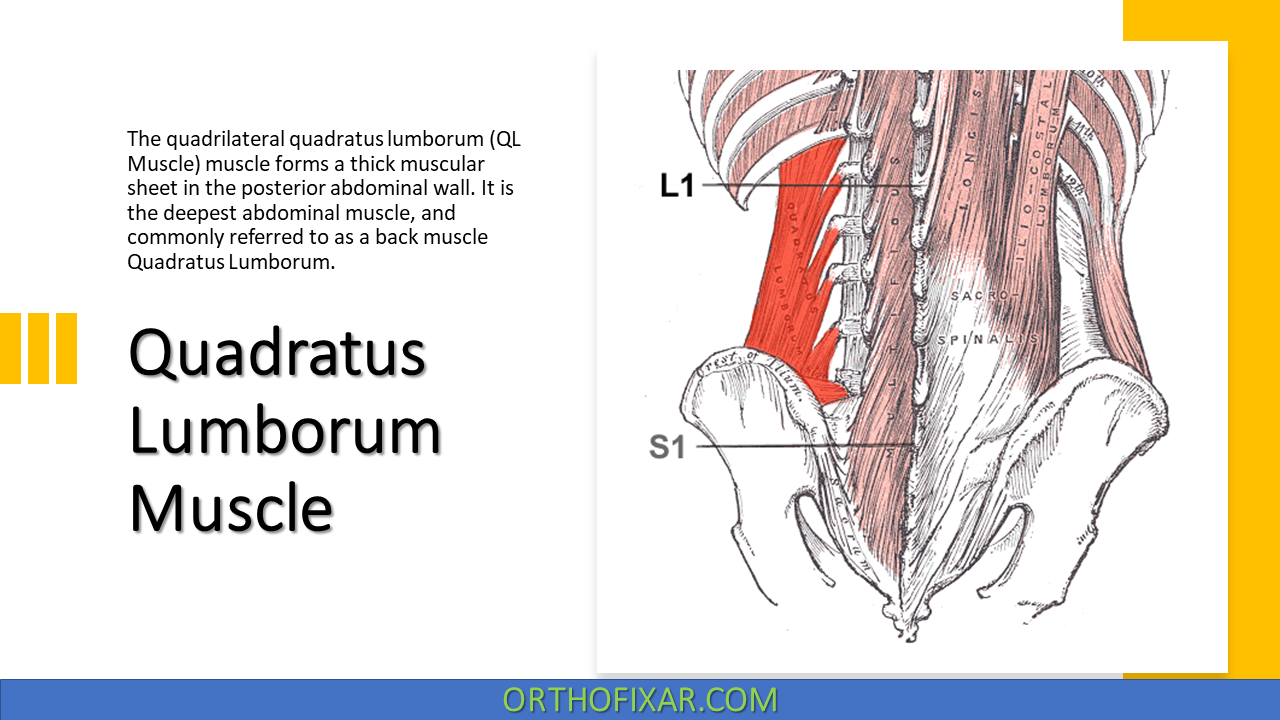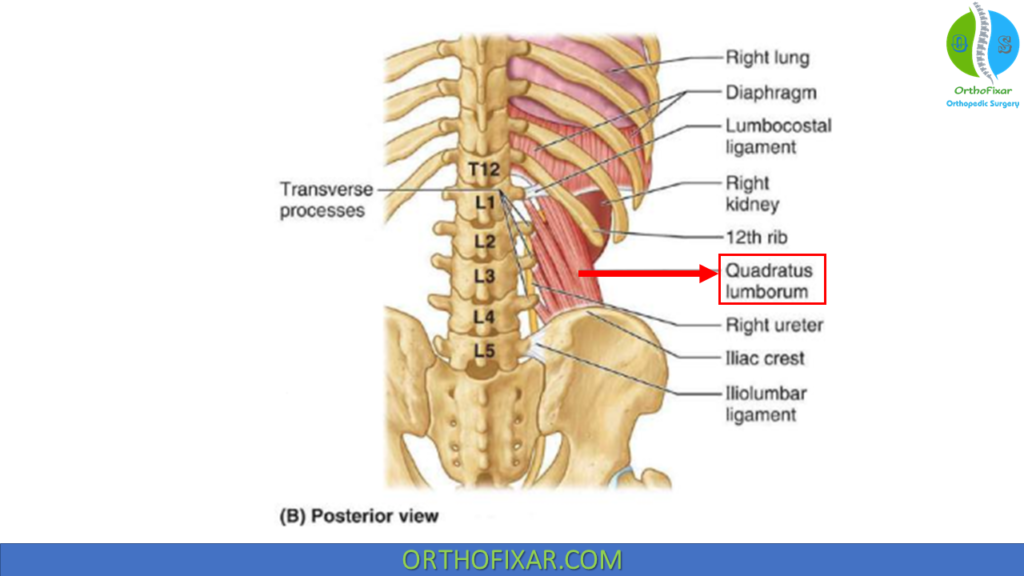Quadratus Lumborum Muscle

The quadrilateral quadratus lumborum muscle (QL Muscle) forms a thick muscular sheet in the posterior abdominal wall. It is the deepest abdominal muscle, and commonly referred to as a back muscle Quadratus Lumborum.
Quadratus Lumborum muscle lies adjacent to the lumbar transverse processes and is broader inferiorly. Close to the 12th rib, the lateral arcuate ligament crosses the quadratus lumborum.
The subcostal nerve passes posterior to this ligament and runs inferolaterally on the quadratus lumborum. Branches of the lumbar plexus run inferiorly on the anterior surface of this muscle.
See Also: Iliacus and Psoas Major Muscles
Quadratus Lumborum Muscle Anatomy
QL muscle has three layers with muscle fibers that have different orientation:
- The superficial layer is a thin layer comprising iliocostal muscle fibers (from the iliac crest to the ribs) and iliothoracic (from the iliac crest to the lateral area of the vertebral body of T12) which fibers have a tendinous or even muscular termination.
- The intermediate layer comprises lumbocostal muscle fibers (from the transverse processes of the lumbar vertebrae to the 12th rib). They are muscle fibers that vary significantly in size, direction, and thickness.
- The posterior layer consists of lateral iliocostal fibers and medially from iliolumbar fibers (from the iliac crest, connecting to the transverse processes of the lumbar vertebrae). The iliocostal muscle bundles may involve the thoracolumbar fascia, inserting themselves with their tendon endings. This layer is thicker in the caudal area and more tapered in the rostral portion
See Also: Hamstring Muscles
Origin
QL muscle originates from:
- Iliac crest,
- Iliolumbar ligament
Insertion
The two QL muslces’ insertions are on the transverse processes of the upper four lumbar vertebrae (L1-L4) plus the lower posterior border of the 12th rib.
- Inferior border of rib 12,
- Transverse processes of vertebrae L1-L4
Action
The actions of QL muscle depends on bilateral contraction or unilateral contraction:
- Bilateral contraction: fixes Ribs 12 during inspiration (The quadratus lumborum assists the diaphragm in inhalation) and trunk extension.
- Unilateral contraction: lateral flexion of trunk (ipsilateral).
- Vertical stabilization of pelvis, lumbar spine, and lumbosacral junction. Prevents collapse of the vertebral column in the frontal plane (i.e. scoliosis)
- Reserve mover actions: anterior pelvic tilt.
- Contralateral lateral pelvic rotation.
Innervation
QL gets its nerve supply from:
- Subcostal nerve (T12),
- anterior rami of spinal nerves L1-L4.
Blood Supply
QL gets its blood supply from many sources:
- Lumbar, median sacral, iliolumbar and subcostal arteries.

| Origin | Iliac crest, Iliolumbar ligament |
| Insertion | Inferior border of rib 12, Transverse processes of vertebrae L1-L4 |
| Innervation | Subcostal nerve (T12), anterior rami of spinal nerves L1-L4 |
| Blood Supply | Lumbar, median sacral, iliolumbar and subcostal arteries |
| Action | Bilateral contraction: fixes Ribs 12 during inspiration, trunk extension Unilateral contraction: lateral flexion of trunk (ipsilateral) |
Quadratus Lumborum Pain
The quadratus lumborum muscles can be the source of back pain when overused, or in association with scoliosis or weak gluteal muscles. constant contraction while seated can overuse the quadratus lumborum, resulting in muscle fatigue. A constantly contracted quadratus lumborum, like any other muscle, will experience decreased blood flow, and, in time, adhesions in the muscle and fascia may develop, the end point of which is muscle spasm.
For unilateral lower back pain, stretching and strengthening the quadratus lumborum are recommended. Heat or ice applications and massage may also be beneficial as part of a comprehensive treatment plan. However, recent studies suggest these methods alone don’t offer long-term benefits. Therefore, a thorough evaluation of muscular imbalances and movement patterns by a therapist is crucial to address these underlying issues effectively.
References & More
- Clinically Oriented Anatomy – 8th Edition
- Bordoni B, Varacallo M. Anatomy, Abdomen and Pelvis, Quadratus Lumborum. [Updated 2023 Jul 17]. In: StatPearls [Internet]. Treasure Island (FL): StatPearls Publishing; 2023 Jan-. Available from: https://www.ncbi.nlm.nih.gov/books/NBK535407/
- Phillips S, Mercer S, Bogduk N. Anatomy and biomechanics of quadratus lumborum. Proc Inst Mech Eng H. 2008 Feb;222(2):151-9. [PubMed]
December 29, 2023
OrthoFixar
Orthofixar does not endorse any treatments, procedures, products, or physicians referenced herein. This information is provided as an educational service and is not intended to serve as medical advice.
- Lifetime product updates
- Install on one device
- Lifetime product support
- Lifetime product updates
- Install on one device
- Lifetime product support
- Lifetime product updates
- Install on one device
- Lifetime product support
- Lifetime product updates
- Install on one device
- Lifetime product support